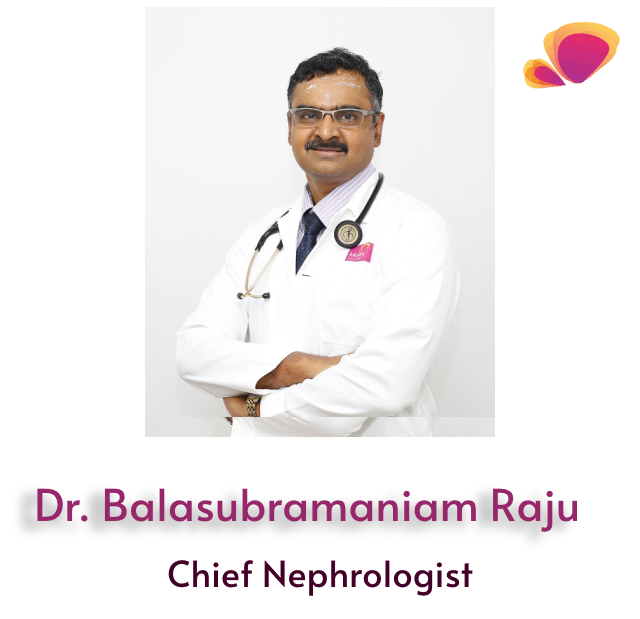Message from Team IMA Chennai Kauvery Alwarpet Branch

Dear colleagues
Wishing you all a very Happy 75th Independence Day.
Greetings and best wishes from IMA Kauvery Alwarpet branch.
Most of the articles in this edition are contributed by our Nephrology Department, which has evolved as a Super Speciality training centre, under the able leadership of Dr R Balasubramanian, our best wishes to them.
Yours in IMA service,
Dr S Sivaram Kannan
President

The kidneys perform life-sustaining job of filtering and returning to the bloodstream about 200 quarts of fluid every 24 hours.
Diabetes, Hypertension and our lifestyle have major impact over renal function.
This month’s IMA Journal focuses on kidneys and their function
Long live IMA.
Dr. Bhuvaneshwari Rajendran
Secretary

Dear friends
Happy to meet you through this month’s IMA JOURNAL.
The theme for this month is NEPHROLOGY. Happy to share the different interesting case scenarios from our department.
Nephrology has become National Board recognised Super Specialty department and we have contributions from our post graduates too.
We welcome your feedback and suggestions.
Thank you.
Long live IMA.
With regards
Dr R Balasubramaniyam
Editor

NELL 1 Staining in Primary Membranous Nephropathy – A Case Report
History
Mr. S. 45 years presented with gross edema for 2 months. He did not have history of oliguria, hematuria, breathlessness, arthralgia, fever or any other constitutional symptoms. He gave history of passing frothy urine. He was evaluated and found to have nephrotic range of proteinuria (8 grams per day), normal renal chemistry (urea 20 mg% and creatinine – 1.0 mg %), Hypoproteinemia (serum proteins 6 gm % and albumin 3.2 gm %) and hypertriglyceridemia with normal sized kidneys on ultra-sonogram.
He gave history of taking indigenous medications for his eczema.
He was diagnosed to have NEPHROTIC SYNDROME and towards defining the histology he underwent renal biopsy.

Renal Transplantation Vs Dialysis – A Survival Advantage and a Brief Introduction
Chronic kidney disease is an important public health burden worldwide. The survival advantage of transplantation has been well proven over and above that on dialysis. Patients who have undergone transplantation have definite survival advantage in terms of mortality benefits. The overall graft survival has improved to nearly 85% for 10 years from 55% in 10 years over the past few decades. This is due to better immunosuppressive medications and better monitoring. The graft survival in Taiwan and the United States are nearly 92-95%. Deceased donor programs have also resulted in better survival rates based on better allocation of kidneys according to Kidney donor profile index (KDPI) and estimated post-transplant survival rates (EPTS). The survival rate in Europe and Australia has been reported to be better than the United States as the insurance coverage for the medications are extended in these 2 continents.

Rhabdomyolysis and Acute Kidney Injury
Rhabdomyolysis is the breakdown of skeletal muscles and release of its contents like myoglobin, lactate dehydrogenase, aspartate aminotransferase and alanine aminotransferase. Historically, this entity was discovered during the World War II, when large-scale crush injuries were reported.
Etiology of Rhabdomyolysis
Common causes are crush injury, viral infections like coxsackie, parvovirus, drugs like statins, toxins like alcohol, cocaine and artificial creatine supplements (used for body-building), seizures, prolonged immobilisation and limb compartment syndrome. Rare causes include congenital myopathies involving glycogen storage disorders, malignant hyperthermia and neuroleptic malignant syndrome.

Organ Donation – FAQs
Organ Donation day is observed on the 13th August every year with the objective of raising awareness of about organ donation to all. There are many patients waiting on the deceased donor organ transplant list and many die even without getting a suitable organ donor. The deceased donor program although has improved in our country in the last 2 decades, there is still a lag between the organ demand and the supply. This is mainly due to inhibition from the people and their immediate family when it comes to organ donation which is often discussed in the last minute to them and their obvious answer for consent to donate organs is a no.
Organ donation is a very a noble act and the Life continues after one’s death through organ donation. One organ donor can save 8 lives if all the organs in his/her body are functioning normally. On 13th August of every year people across the nation are encouraged to “pledge” the organs for donation this day.

Beta 2-microglobulin amyloidosis causing carpal tunnel syndrome
Beta 2-microglobulin amyloidosis is a common condition affecting patients on long-term hemodialysis Carpal tunnel syndrome is the most common mononeuropathy in dialysis patients caused by compression of the median nerve at the level of wrist where it passes via narrowed carpal tunnel.
Case report
A 75 year old female, diabetic and hypertensive for more than 10 years, on irregular treatment presented to us in End stage renal failure stage (ESRD). Started on maintenance HD (low-flux dialyzer) thrice weekly through AV fistula, since November 2017. After being on dialysis for past 4 years, she recently complained of small joint pain on both upper and lower limbs and numbness of hands.

Quadratus Lumborum Block – An emerging analgesic technique for Nephrectomies
Introduction
The quadratus lumborum block is a novel truncal block, gaining popularity among perioperative analgesic technique in many abdominal surgeries nowadays. Inparticular, the quadratus lumborum block is fast becoming an appealing replacement to epidural as it lacks central neuraxial block side effects. It has been well proved in caesarean sections, hip arthroplasty and gynecologic surgery. It’s the latest addition to this line was open and lapnephrectomies. This article deals with various approaches of QLB and the analgesic effectiveness in nephrectomies.
QLB types and approaches
Four types of approaches were described for quadrates lumborum blocks namely anterior, lateral, posterior…


